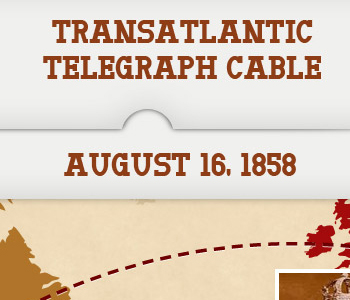Click to view full Infographic Having utilized oceangoing vessels to carry mail for centuries, the completion of a transatlantic telegraph cable opened the United States and Britain to the possibility of near-instantaneous communication when Queen Victoria sent a brief congratulatory message to American President James Buchanan on August 16, 1858. Within weeks, though, the cable failed and the system had to be replaced entirely. Formed in 1856, the Atlantic Telegraph Company came together when businessmen from both sides of the ocean set out to apply the rapidly-advancing technology to connect the eastern US with Britain. Wires had begun to extend further and further into the American West early in the 1850s – not to mention connecting Britain and France – so Cyrus Field, Charles Tilston Bright and John Watkins Brett worked in their respective countries to find funding for the project. The effort began in earnest late that year, when investors contributed £350,000 to have the organization incorporated. Throughout 1857, teams worked to determine the best course for the large cable to be laid across while electricians and engineers determined the best materials and design for construction. Made up of seven copper wires covered in 18 strands made of iron, the cable ended up weighing more than one ton per nautical mile. Under the guidance of E. O. W. Whitehouse, the connection was completed in early August the following year with the help of four British and American ships. So it was that, on August 15, 1858, Queen Victoria could write: “The Queen desires to congratulate the President upon the successful completion of this great international work.” President Buchanan, with a bit more flair, replied: “May the Atlantic Telegraph, under the blessing of Heaven, prove to be a bond of perpetual peace and friendship between the kindred nations, and an instrument designed by Divine Providence to diffuse religion, civilization, liberty and law throughout the world.” As the leaders exchanged messages, Americans, stunned by the achievement, gathered at post offices to read the conversation the following day and marveled – but the link would not last for long. Whitehouse, attempting to speed up the extended transmission times (one of Queen Victoria’s messages took more than 16 hours to be received), decided to apply additional voltage to the cable and rendered it inoperable just three weeks later. Though historians argue the construction would not have held up due to poor understanding of the effect saltwater could have, Whitehouse was immediately dismissed for his perceived role in the failure. It would be another seven years before another attempt could be made at laying a new cable. Though unsuccessful at first, transmission resumed on July 28, 1866 using a line constructed of more durable substances. Within months, a second line was operational and, by the 1870s, the technology had grown to allow multiple messages to be sent in either direction at once. Within four decades, an intricate network of cables connected Britain, France, Germany and the United States.
August 16, 1858 CE – Queen Victoria Contacts US President James Buchanan via the Transatlantic Telegraph Cable
Click to view full Infographic Having utilized oceangoing vessels to carry mail for centuries, the completion of a transatlantic telegraph cable opened the United States and Britain to the possibility…
515
